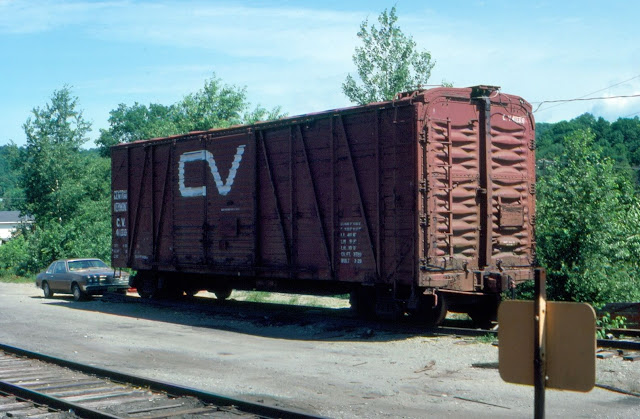These cars were in service for a very long time – through the late 1960s, but they really didn’t change in appearance all that much over the decades.
For perhaps more detail than anyone wants on these cars, I’d refer you to the following:
- Ed Beaudette did an article in MR (August 2001 I recall) that included prototype drawings of the CV/GTW 1-1/2 door as built cars (CV's 41000-series).
- There were a set of drawings in Mainline Modeler sometime in the late 1980s – in that case they were shown as listed as GTW cars, with no mention of the Central Vermont.
- The best reference for these cars is Steve Horsley’s article (which is part of an outstanding ongoing series on CV freight cars) in Volume 24, Issue #4 f the CVRHS “Ambassador.” I’d highly recommend checking that issue out.
Over the years I’ve built a dozen or so more of the Steam Shack/Funaro resin kits. A couple of things to note on the F&C kit include:
- The end door casting kind of just hangs above the roofline and doesn’t really capture the beefy look of the prototype on the B end of the car. See this photo of the door end, and compare with the F&C model to see what I mean:
- My F&C kits (like me, they’re old!) came with regular ladders – some of the newer F&C kits come with Tichy “Canadian” ladders – neither of these are correct. The CV cars had an integrated sill step (basically the “stirrup” is welded to the ladder stiles, not the car side), but the shape of the step on the Tichy ladder isn’t correct.
- Compare the side ladder and stirrup in this photo of a 44000 series car with the Tichy part to see what I mean:
- The cars had wood running boards through most of their service lives. It’s possible a few of them may have received steel running boards, but I’ve never seen any photo evidence of such. I have seen some of these cars with steel brake platforms.
Now we get to the issue with these kits that comes up whenever we discuss them – the trucks.
The cars rode on cast steel ARA U-section trucks with spring planks and Barber lateral motion bolsters equipped with six springs per side frame--a style called "increased spring capacity trucks" by several manufacturers.
The MR article reference above states the ECW 9074 70-ton "Bettendorf" trucks are closest. That’s a typo – it should be 9064 (I started editing the article, but had left the MR staff before it was published and a couple of minor, but annoying errors, such as this one, crept into the copy.)
I got the reference to those trucks after extensive back and forth with Richard Hendrickson – and though those ECW trucks might look the closest, I’ve never bothered using them, or even trying to find a set since the operating qualities of ECW trucks are marginal at best.
For many years I used good-ole' Kadee "Bettendorf" trucks under these cars. Starting several years ago I substituted Tahoe Model Works 50-ton Dalman 2-Level trucks. While certainly not an exact match they roll well, and at least have a large number of visible springs when viewed from the side.
As a side note, my first item published in a “real” model railroad magazine was a review of this kit (marketed by Steam Shack but produced by Steve Funaro). Just for fun, here’s a photo of that model – warts and all - including its completely incorrect Kadee "Bettendorf" trucks! - on Paul Dolkos’ former B&M White Mountain Division:






While not correct, I would use the Kadee Barber S-2-B trucks in the HGC material. They do have the three visible springs, which are a clear eye catcher for the prototypes that had them.
ReplyDelete